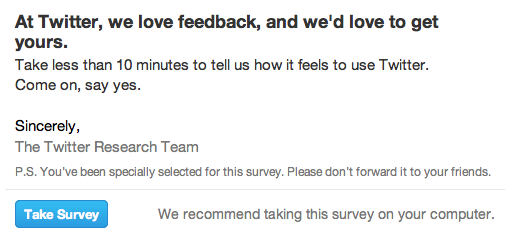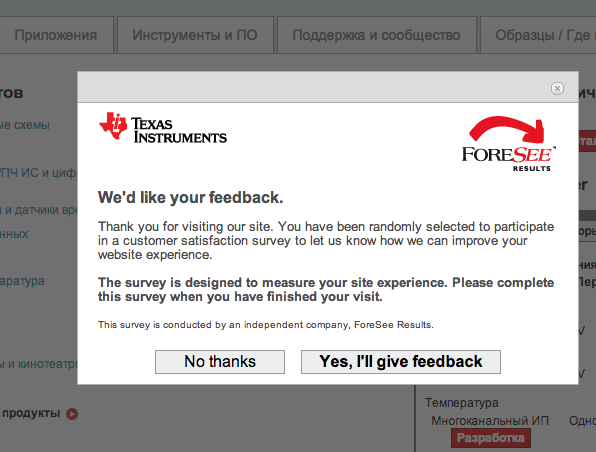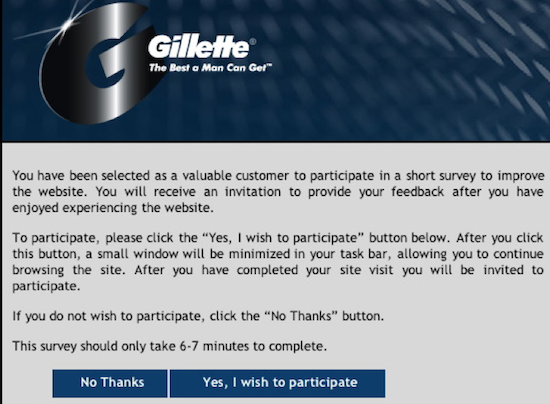It seems like everyone is running a web survey these days.
While I appreciate the importance of asking your website visitors what they think, too many of these surveys are poorly implemented.
So here are five tips to consider before launching your web survey…
1. Make it worth my while
I used to love to participate in focus groups. But I didn’t do it just to be nice (and get a sneak peak at new products). The focus groups paid me for my time.
On the Internet, most web surveys offer little (or nothing) in exchange for my time.
Consider this plea from Twitter, which attempts to coax you with cuteness into participating:

Facebook doesn’t even try to be cute. But, like Twitter, nothing in exchange for my time:

Why, Facebook?
Why should I give you 3-4 minutes of my time? (Or, to be honest, an additional 3-4 minutes of my time.)
I’m not suggesting you must pay people to get them to participate. But offer them something. A chance to win a gift certificate or free product is always a nice incentive.
Some surveys will tell me they want my feedback to help them improve my user experience. This isn’t much, but it’s something. And it displays an understanding that my time has value and that the company appreciates it. The New York Times does that:

And how about offering to share the results of your survey with your respondents? This too would be something of value that many of your respondents might appreciate. I certainly would.
2. Speak my language
During the production of The Web Globalization Report Card, I visited a few hundred websites. Roughly 35% of these websites featured a web survey, though only a small fraction of these websites offered surveys in the local user’s language. For example, as shown below, a visitor to the Texas Instruments Russia website encounters a pop-up survey in English.

Perhaps the company was targeting English-speaking web users in Russia, though I doubt it. Most companies simply overlook non-English speaking markets when they launch “global” web surveys.
Fortunately a few companies do invest in localizing their web surveys.Best Buy localized its survey for its Spanish-language website, shown here:

So the lesson here is simple: If you’re planning a global web survey, invest in making it truly global.
And keep in mind that localizing a survey is not simply a matter of translation. Questions may need to be completely rewritten, added or deleted.
3. Be brief
The following survey, which I encountered last year, is so text-heavy and complex that I wonder who actually bothers to participate.

And how valuable is the feedback from someone who has the spare time to navigate such a survey request, let alone the survey?
4. Don’t block navigation
As you can see below, a web survey overlay on the Siemens website blocks my ability to select a country website.
Now let’s suppose I don’t speak English and I just want to get to my country website.

Clearly, overlays are designed to not be ignored. But consideration should be given to web users who may not speak the language of the global home page.
These people are simply trying to move along to their localized websites and web surveys can be very disruptive.
5. Don’t be creepy

I think surveys that interrupt you with a pop-up when you first visit and then promise to interrupt you again when you leave the website are a bit creepy.
Most people don’t like the idea of being watched online and this feels like that — like someone hovering too close while you use the ATM machine.
And how about this one from LG:

This message implies that LG somehow knows how to get in touch with me via email or text.
I realize this isn’t the case but I’m not sure all web users will know this.
Bonus Tip: Test your survey on friends and family
Too often we launch surveys and promotions without asking a few simple questions:
- Would my mom or dad bother to take this survey?
- Would my significant other?
- Would my child?
- Would I take the time to complete it?
It doesn’t matter if these people aren’t your “target” web users. Because everyone’s a web user these days. Everyone’s busy. And everyone is encountering web surveys.
If the answers to these questions are NO, then find out how to get them to YES. Often this process alone will help you address many of the points mentioned above.
